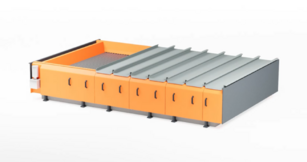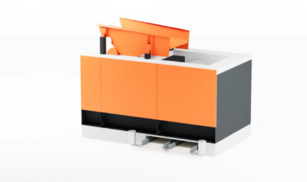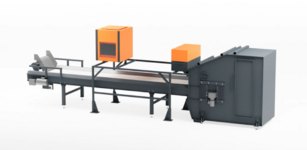from Pfleiderer conserves valuable resources
When it comes to quality, we make no compromises. This quality standard also includes the highest quality wood recycling of waste wood. This ensures that the raw material is utilised in the best possible way – and with minimal impact on nature and the environment. This is why Pfleiderer recycles wood multiple times and obtains supply from responsible sources.
With ReSource, we demonstrate how waste wood is kept in the cycle of material use as a valuable secondary raw material, thus conserving resources and supporting carbon storage.
Full exploitation of waste wood recycling

...OF WASTE WOOD ARE PRODUCED IN GERMANY EVERY YEAR; DEPENDING ON THE ECONOMIC SITUATION. MORE THAN 50% OF THIS QUANTITY CAN THEORETICALLY BE PUT TO HIGH-QUALITY USE AND PROCESSED INTO A VALUABLE SECONDARY RAW MATERIAL FOR THE PRODUCTION OF NEW WOOD-BASED MATERIALS.
The requirements of the German Waste Wood Ordinance, are governed by the strictest regulations in Europe in this area, ensuring that as many elements and compounds as possible that are hazardous to health are removed from the cycle. According to this regulation, only certain categories of waste wood are authorised for recycling:
| Waste wood category A I: | Natural or mechanically processed waste wood (pallets, solid wood furniture).
|
| Waste wood category A II: | Glued, coated and painted waste wood without organohalogen compounds in the coating and without wood preservatives (furniture made of particleboard, such as kitchens and wardrobes).
|
| Waste wood category A III: | Waste wood without wood preservatives with organohalogen compounds in the coating is only permitted after prior cleaning.
|
| Waste wood category A IV: | Waste wood treated with wood preservatives (railway sleepers, utility poles, hop poles, vine poles and other waste wood).
|
At our particleboard facilities in Gütersloh, Leutkirch and Neumarkt, we only use materials from waste wood categories A I and A II for waste wood utilisation. Categories A III and A IV are only used for thermal utilisation.
Our particleboard is regularly tested in our Arnsberg central laboratory working closely with our suppliers to ensure that the product quality standards for waste wood utilisation are fully complied with.
ReSource shows how Resource conservation works
For decades, we have been working with our partners in the field of waste wood utilisation and processing development innovating new methods to keep the raw material wood in the material cycle for as long and as extensively as possible. This is reflected in our customised cleaning systems.
We accept processed recycled wood chips made from waste wood from our partners, containing only a minimal amount of impurities. In addition, we take measures in our own production preparation to optimise quality and increase the degree of utilisation.
Complex Recycling steps for excellent results
Our internal utilisation process starts with the pre-cleaning of the delivered wood chips and fractionation from fine to coarse. The resulting batches then pass through several stations in which the remaining impurities are selectively removed.
Discover the individual cleaning stations here:

Pre-Sorting

Formation of material fractions
Pfleiderer ReSource works very precisely in pre-sorting. Material fractions are formed - medium, small and very fine particles are separated into fractions, post-cleaned and transferred to production. Pfleiderer also recycles very small particles of fine material that are already incinerated by competitors.
Ferrous metal seperation

Processing of coarse wood chips
In the first phase of the coarse of shredded wood pieces processing, ferrous metals are separated by magnets.
Non-ferrous metal separation

Separation of non-ferrous metals
In the next phase, non-ferrous metals are separated using the eddy current process.
X-ray sorter

Sorting process with X-rays
Non-metallic heavy materials are identified and removed by a sorting process using X-rays. The removed material is additionally examined in a water bath for recyclable wood parts so that it can be returned to the material flow.
Optical sorter

AI-supported, optical process
Plastics, MDF and remaining metal are identified and removed by infrared using an AI-supported optical process. The other material is once again dragged through the process in order to optimize the proportion of recoverable material.
Knife ring flaker

Processing of waste wood
The treated and decontaminated waste wood can then be turned into top-quality wood chips in a knife ring flaker.
Pioneers of waste wood recycling
As pioneers in waste wood recycling, our particleboard are produced with an average recycled wood content of around 60%. In 2020, we processed around 700,000 tonnes of post-consumer recycled material, continuously increasing this proportion systematically. We want wood to be used as a material for as long as possible before it is incinerated at the very end. This results in greater benefits for both society and the economy.
ReSource is an innovative recycling process for waste wood that makes the separation of foreign matter incredibly reliable and allows us to process the highest quality and quantity of chips. This enables us to increase the recyclable proportion of waste wood and optimise the recyclability from procurement to product. This makes particleboard production more flexible, sustainable, high-quality and climate-friendly than ever before and features the highest level of recycling competence.

